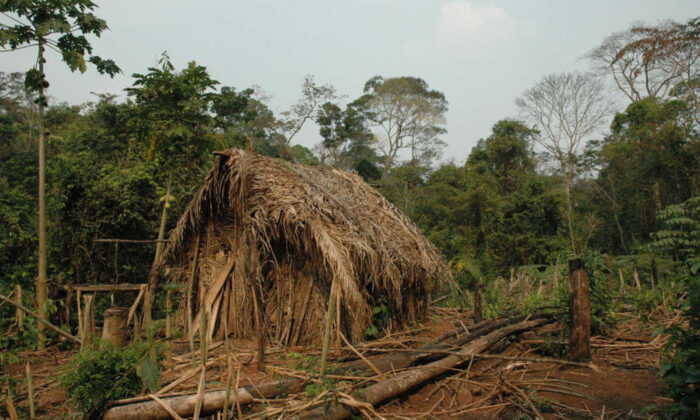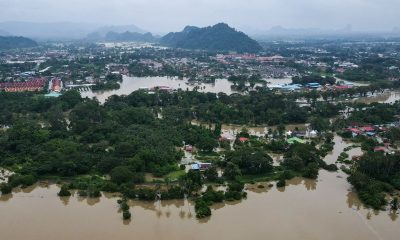International
‘Man of the hole’ dies, last known survivor of Amazon tribe

AFP | by Ramon SAHMKOW
For more than 20 years he lived alone in the Brazilian Amazon eating nuts, fruit and game — a symbol of the struggle of indigenous people who exist in isolation in the rainforest.
Now this man whose very name was unknown is dead, and his passing has made headlines around the world.
His life was marked by massacres that left him as the lone survivor of a small tribe attacked by gunmen apparently hired by ranchers seeking to exploit the pristine Amazon.
He was found dead lying in a hammock on August 23 in Tanaru Indigenous Territory. Authorities found no signs of violence and believe he died of natural causes.
The man was covered in the bright feathers of a bird called the guacamaya, a kind of macaw, local news reports said.
The Tanaru Indigenous Territory covers 8,000 hectares (30 square miles) of protected rainforest in Brazil’s southwestern Rondonia state, bordering Bolivia. The reserve is surrounded by sprawling cattle ranches.
Rife with rogue miners and wood cutters whose work is illegal, it is one of the most dangerous regions of Brazil, according to the Survival International NGP.
The Tanaru land “is like an oasis of green in the sea of destruction,” said NGO director Fiona Watson.
An arrow shot
The “man of the hole” was first spotted in 1996 by a documentary team traveling with officials of the National Indian Foundation, a government agency that was probing a massacre committed against his tribe.
Proving the presence of indigenous people in the Tanaru forest area was necessary in order to grant the area legal protection.
The footage was featured in a documentary called “Corumbiara” in 2009.
In it, the man’s eyes are seen peering out from inside a straw hut. A spear pokes out at one point, as if to scare visitors away. But no one utters a word.
Over the years Funai teams came back with representatives of neighboring tribes to try to determine what language the man spoke and learn more about his people.
But he made clear he did not want to engage anyone. Feeling threatened, one time he shot an arrow that left a visiting team member seriously wounded.
“One can only imagine what this man was thinking, going through, living on his own, not able to speak to anybody and I think very frightened because any outsider for him represented a threat, given his terrible experience,” Watson said.
After that, authorities just tried to patrol his territory and look for signs that he was still alive.
In the last known footage of him alive — shot in 2011 but not released until seven years later — he is seen semi-naked cutting down a tree with an axe.
Besides bows and arrows that showed he hunted, there were gardens where he grew fruit and vegetables, such as papaya and manioc.
“We saw one of his gardens and it was full of produce — very beautifully kept,” said Watson who visited the site in 2005.
But what most fascinated researchers were the many holes he dug — some two meters (seven feet) deep and with sharp spears at the bottom.
Funai said officials found 53 places that had been his home in the Tanaru territory, always with the same structure: a small straw hut with one door and a hole.
The holes were used to trap animals but experts think they may also been a place for him to hide from intruders or had some kind of spiritual purpose.
The holes, Watson said, are “a mystery that has died with him,” as is the history of the Tanaru people.
Funai has identified 114 indigenous groups that live in isolation in Brazil’s part of the Amazon.
International
Climate-driven rains trigger one of Indonesia’s deadliest flood emergencies in years

A torrential monsoon season, compounded by two unusual tropical cyclones, has triggered intense rainfall in several regions since last week, including southern Thailand, northern Malaysia, and large parts of Indonesia.
Climate change has recently intensified rainfall patterns, as a warmer atmosphere is able to hold more moisture. In Indonesia, desperation is growing among those affected by the disaster due to the slow pace of rescue operations and the distribution of humanitarian aid.
Relief agencies warned that the scale of the emergency is nearly unprecedented, even for a country accustomed to frequent natural disasters.
Across the island of Sumatra, the death toll was revised downward to 770 fatalities and at least 463 people still missing as of Wednesday night. Earlier, the national disaster management agency had reported 804 deaths.
Gathering accurate information on the ground remains difficult, as many regions are still cut off due to flood damage, widespread power outages, communication failures, or a combination of all three.
International
Russian authorities ban Roblox citing child safety and moral concerns

Russia has blocked access to the U.S.-owned game creation platform Roblox, accusing it of distributing extremist materials and what authorities described as “LGBT propaganda,” state media reported on Wednesday.
The country has repeatedly threatened to ban certain foreign digital platforms, a move that human rights organizations view as part of broader efforts by authorities to tighten control over internet use.
In a statement released through Russian news agencies, the federal communications watchdog Roskomnadzor accused Roblox of hosting “inappropriate content that can negatively affect the spiritual and moral development of children.”
“The game exposes minors to sexual harassment, tricks them into sharing intimate photos, and encourages them to commit acts of depravity and violence,” the regulator claimed.
Last week, the same agency also threatened to ban WhatsApp, the country’s second most widely used messaging app, accusing it of failing to prevent criminal activity.
Roblox, which is owned by the U.S.-based Roblox Corporation, did not immediately respond to a request for comment.
According to company data for 2024, the platform has around 100 million daily users worldwide, nearly 40% of whom are under the age of 13.
Other countries, including Qatar, Iraq and Turkey, have also restricted or banned Roblox, mainly over concerns about the safety of underage users. In the United States, the states of Texas and Louisiana have filed lawsuits against the platform on similar grounds.
International
El Chapo’s son Joaquín Guzmán López pleads guilty to U.S. drug trafficking charges

Joaquín Guzmán López, one of the sons of notorious Mexican drug lord Joaquín “El Chapo” Guzmán, pleaded guilty on Monday to drug trafficking charges in a U.S. court, months after his brother Ovidio reached a similar plea agreement, according to local media reports.
The defendant appeared before a federal court in Chicago early Monday afternoon and changed his previous plea in the case, the Chicago Tribune reported. U.S. authorities accuse him of forming, together with his three brothers, the cartel faction known as “Los Chapitos.”
The group is believed to have continued the operations of El Chapo, who has been serving a life sentence in the United States since 2019.
Guzmán López, 39, was arrested after landing in Texas in a small aircraft alongside cartel co-founder Ismael “El Mayo” Zambada.
-

 Central America4 days ago
Central America4 days agoHonduras’ China–Taiwan Future Hinges on Sunday’s Presidential Election
-

 Central America3 days ago
Central America3 days agoHonduras Extends Voting by One Hour Amid High Turnout, CNE Announces
-

 International3 days ago
International3 days agoHong Kong police arrest 13 over deadly high-rise fire that killed 151
-

 International3 days ago
International3 days agoSri Lanka and Indonesia deploy military as deadly asian floods kill over 1,000
-

 International3 days ago
International3 days agoTrump says asylum decision freeze will remain in place “for a long time”
-

 International3 days ago
International3 days agoChile enters runoff campaign with Kast leading and Jara seeking a last-minute comeback
-

 International2 days ago
International2 days agoVenezuela authorizes return flights as U.S. continues deportations amid rising tensions
-

 International2 days ago
International2 days ago20,000 rounds stolen from german army after driver leaves cargo unattended
-

 International2 days ago
International2 days agoEl Chapo’s son Joaquín Guzmán López pleads guilty to U.S. drug trafficking charges
-

 International8 hours ago
International8 hours agoRussian authorities ban Roblox citing child safety and moral concerns
-

 International2 days ago
International2 days agoTrump convenes National Security Council as U.S.–Venezuela tensions intensify
-

 International8 hours ago
International8 hours agoClimate-driven rains trigger one of Indonesia’s deadliest flood emergencies in years
-

 Sin categoría8 hours ago
Sin categoría8 hours agoJuan Orlando Hernández’s family takes time to decide next steps after surprise U.S. release






























